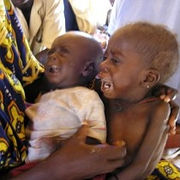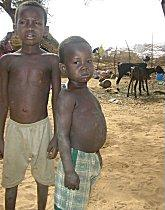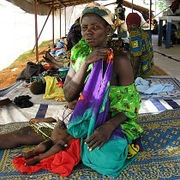
2005-06 Niger food crisis
Encyclopedia

Food security
Food security refers to the availability of food and one's access to it. A household is considered food-secure when its occupants do not live in hunger or fear of starvation. According to the World Resources Institute, global per capita food production has been increasing substantially for the past...
crisis occurred in the regions of northern Maradi, Tahoua
Tahoua (department)
Tahoua is one of eight administrative Regions in Niger. The capital of the Region is the Commune of Tahoua. The Region covers 106,677 km². The Governor of Tahoua Region is Elhadj Mahamadou Zéti Maiga...
, Tillabéri
Tillabéri
Tillabéri is a town in northwest Niger. It is situated 120 km northwest of the capital Niamey on the River Niger. It is an important market town and administrative center, it is capital of the department of Tillabéri and Tillabéri Region. The town had a population of over 16000 at the 2001 census...
, and Zinder
Zinder
Zinder is the second largest city in Niger, with a population of 170,574 by 2005 was estimated to be over 200,000...
of Niger
Niger
Niger , officially named the Republic of Niger, is a landlocked country in Western Africa, named after the Niger River. It borders Nigeria and Benin to the south, Burkina Faso and Mali to the west, Algeria and Libya to the north and Chad to the east...
from 2005 to 2006. It was caused by an early end to the 2004 rains, desert locust
Desert locust
Plagues of the desert locust have threatened agricultural production in Africa, the Middle East, and Asia for centuries. The livelihood of at least one-tenth of the world’s human population can be affected by this voracious insect...
damage to some pasture lands, high food prices, and chronic poverty. In the affected area, 2.4 million of 3.6 million people are considered highly vulnerable to food insecurity. An international assessment stated that, of these, over 800,000 face extreme food insecurity and another 800,000 in moderately insecure food situations are in need of aid
Humanitarian aid
Humanitarian aid is material or logistical assistance provided for humanitarian purposes, typically in response to humanitarian crises including natural disaster and man-made disaster. The primary objective of humanitarian aid is to save lives, alleviate suffering, and maintain human dignity...
.
Background
The crisis had long been predicted after swarms of locusts2004 locust outbreak
The 2004 locust outbreak was the largest infestation of Desert Locust in West and North Africa in more than 15 years and affected a number of countries in the fertile northern regions of Africa.-Development:...
consumed nearly all crops in parts of Niger during the 2004 agricultural season. In other areas, insufficient rainfall
Drought
A drought is an extended period of months or years when a region notes a deficiency in its water supply. Generally, this occurs when a region receives consistently below average precipitation. It can have a substantial impact on the ecosystem and agriculture of the affected region...
resulted in exceptionally poor harvests and dry pastures affecting both farmers and livestock breeders. An assessment carried out by the government of Niger, the United Nations
United Nations
The United Nations is an international organization whose stated aims are facilitating cooperation in international law, international security, economic development, social progress, human rights, and achievement of world peace...
and international Non Governmental Organizations reached a general consensus that the crisis, while locally severe, had not reached the level of famine
Famine
A famine is a widespread scarcity of food, caused by several factors including crop failure, overpopulation, or government policies. This phenomenon is usually accompanied or followed by regional malnutrition, starvation, epidemic, and increased mortality. Every continent in the world has...
according to famine scales
Famine scales
Famine scales are the ways in which degrees of food security are measured, from situations in which an entire population has adequate food to full-scale famine. The word "famine" has highly emotive and political connotations and there has been extensive discussion among international relief...
.
Crisis
According to current estimates, the Sahel regionSahel Region
Sahel is one of Burkina Faso's 13 administrative regions. It was created on 2 July 2001 and had a population of 808,928 in 2006. The region's capital is Dori. Four provinces make up the region - Oudalan, Séno, Soum, and Yagha....
as a whole registered a grain surplus of 85,000 tons. However, Niger
Niger
Niger , officially named the Republic of Niger, is a landlocked country in Western Africa, named after the Niger River. It borders Nigeria and Benin to the south, Burkina Faso and Mali to the west, Algeria and Libya to the north and Chad to the east...
and Chad
Chad
Chad , officially known as the Republic of Chad, is a landlocked country in Central Africa. It is bordered by Libya to the north, Sudan to the east, the Central African Republic to the south, Cameroon and Nigeria to the southwest, and Niger to the west...
suffered grain deficits of around 224,000 and 217,000 tons, respectively. An increase in food prices is fuelling the food crisis, especially in Niger, where millions of people are facing risk of food shortages and outright starvation
Starvation
Starvation is a severe deficiency in caloric energy, nutrient and vitamin intake. It is the most extreme form of malnutrition. In humans, prolonged starvation can cause permanent organ damage and eventually, death...
.

Malnutrition
Malnutrition is the condition that results from taking an unbalanced diet in which certain nutrients are lacking, in excess , or in the wrong proportions....
have been reported to be on the rise. The scarcity of water
Water
Water is a chemical substance with the chemical formula H2O. A water molecule contains one oxygen and two hydrogen atoms connected by covalent bonds. Water is a liquid at ambient conditions, but it often co-exists on Earth with its solid state, ice, and gaseous state . Water also exists in a...
and fodder
Fodder
Fodder or animal feed is any agricultural foodstuff used specifically to feed domesticated livestock such as cattle, goats, sheep, horses, chickens and pigs. Most animal feed is from plants but some is of animal origin...
is adversely affecting the health of the cattle
Cattle
Cattle are the most common type of large domesticated ungulates. They are a prominent modern member of the subfamily Bovinae, are the most widespread species of the genus Bos, and are most commonly classified collectively as Bos primigenius...
s, camel
Camel
A camel is an even-toed ungulate within the genus Camelus, bearing distinctive fatty deposits known as humps on its back. There are two species of camels: the dromedary or Arabian camel has a single hump, and the bactrian has two humps. Dromedaries are native to the dry desert areas of West Asia,...
s, sheep and goat
Goat
The domestic goat is a subspecies of goat domesticated from the wild goat of southwest Asia and Eastern Europe. The goat is a member of the Bovidae family and is closely related to the sheep as both are in the goat-antelope subfamily Caprinae. There are over three hundred distinct breeds of...
s that comprise virtually the only source of food and income for nomadic communities. Competition for limited resources has also resulted in some local conflicts.

Zinder
Zinder is the second largest city in Niger, with a population of 170,574 by 2005 was estimated to be over 200,000...
departments
Departments of Niger
||The Regions of Niger are subdivided into 63 Departments . Before the devolution program on 1999-2005, these Departments were styled arrondissements. Confusingly, the next level up had, before 2002-2005 been styled Departments. Prior to a revision in 2011, there had been 36 Departments. A draft...
, with 2.5 per cent of this group identified as severely malnourished children under age five, says UNICEF
United Nations Children's Fund
United Nations Children's Fund was created by the United Nations General Assembly on December 11, 1946, to provide emergency food and healthcare to children in countries that had been devastated by World War II...
quoting recent nutrition surveys by the United Nations
United Nations
The United Nations is an international organization whose stated aims are facilitating cooperation in international law, international security, economic development, social progress, human rights, and achievement of world peace...
and several non-governmental organization
Non-governmental organization
A non-governmental organization is a legally constituted organization created by natural or legal persons that operates independently from any government. The term originated from the United Nations , and is normally used to refer to organizations that do not form part of the government and are...
s.
The food shortage
Famine
A famine is a widespread scarcity of food, caused by several factors including crop failure, overpopulation, or government policies. This phenomenon is usually accompanied or followed by regional malnutrition, starvation, epidemic, and increased mortality. Every continent in the world has...
impacts some 3.3 million people —including 800,000 children under age five— in some 3,815 villages. Officials estimate cereal deficits at 223,448 tons and livestock feed deficits at 4,642,219 tons.
Although rains began early this year and have fallen regularly, initially inspiring hope for a better agricultural season, relief will not come before the harvest in October. Villagers are just now entering into the critical period known as the lean season — the months when food stocks are at their lowest. It is also the moment when farm workers need more caloric energy to cultivate their fields, since most of the agrarian labour in Niger is performed manually.

Response
In late August 2005, the profile of the crisis was raised after UN Secretary-GeneralUnited Nations Secretary-General
The Secretary-General of the United Nations is the head of the Secretariat of the United Nations, one of the principal organs of the United Nations. The Secretary-General also acts as the de facto spokesperson and leader of the United Nations....
Kofi Annan
Kofi Annan
Kofi Atta Annan is a Ghanaian diplomat who served as the seventh Secretary-General of the UN from 1 January 1997 to 31 December 2006...
visited President
Heads of state of Niger
-List of Heads of State of Niger:-Affiliations:-See also:*Niger*List of colonial heads of Niger*Heads of Government of Niger*Lists of Incumbents-References:*...
Tandja Mamadou
Tandja Mamadou
Lieutenant Colonel Mamadou Tandja is a Nigerien politician who was President of Niger from 1999 to 2010. He was President of the National Movement of the Development Society from 1991 to 1999 and unsuccessfully ran as the MNSD's presidential candidate in 1993 and 1996 before being elected to his...
in Zinder. The visit was seen as an attempt to draw attention to the crisis, and also address accusations that the UN had responded slowly. Donors have given less than half of the US$81 million appealed for by the UN.
On January 16, 2006, the UN directed an appeal for US$ 240 million of food aid for West Africa
West Africa
West Africa or Western Africa is the westernmost region of the African continent. Geopolitically, the UN definition of Western Africa includes the following 16 countries and an area of approximately 5 million square km:-Flags of West Africa:...
to feed at least 10 million people affected by the food crisis, with Niger being the worst-affected country.
Aftermath
On March 3, 2008 TV2TV 2 (Norway)
TV 2 is the largest commercial television station in Norway. Over 30% of the time Norwegians spend watching TV is spent watching TV 2. The station has 65% of the market for TV commercials in Norway....
Norway aired the documentary "Sultbløffen" (The Famine Scam) claiming there was no famine in Niger in 2005-06. BBC's Hilary Anderson, UN Emergency Relief Coordinator Jan Egeland
Jan Egeland
Jan Egeland was the United Nations Undersecretary-General for Humanitarian Affairs and Emergency Relief Coordinator from June 2003 to December 2006. Egeland was appointed by Secretary-General Kofi Annan and succeeded Kenzo Oshima...
as well as international media and aid organizations in general were accused of severely overstating and lying about the food situation in the country.
The sources, among them a Norwegian-Swedish foundation of agricultural development and their local assistants, gave a version picturing western media and relief agencies as ignorant towards local agriculture and flora. They cited so-called "food-racism": the perception that local, traditional food and food plants are useless and poisonous, despite the fact that the locals have eaten these for millennia. Second, the perception that the people of Niger are uncapable of living without support from the west, and that large food packages made it hard for local agriculture to compete.
http://www.dagsavisen.no/utenriks/article338072.ece
The film was awarded 3rd prize in the Monte Carlo TV festival of 2008, and won Den Store Journalistprisen in Norway in 2009. However, the BBC attempted to block the international release of the documentary by withdrawing TV2's license to news footage from the summer of 2005.
http://www.guardian.co.uk/media/2008/jul/01/bbc.television
See also
- 2006 Horn of Africa food crisis2006 Horn of Africa food crisisIn 2006, an acute shortage of food affected the countries in the Horn of Africa , as well as northeastern Kenya. The United Nations's Food and Agriculture Organization estimated on January 6, 2006, that more than 11 million people in these countries may be affected by an impending widespread...
- Malawian food crisis
- 2010 Sahel drought
External links
- Jeevan Vasagar, The GuardianThe GuardianThe Guardian, formerly known as The Manchester Guardian , is a British national daily newspaper in the Berliner format...
, August 1, 2005, "Plenty of food - yet the poor are starving: The two faces of Niger" - NIGER: AN EVIDENCE BASE FOR UNDERSTANDING THE CURRENT CRISIS, (PDF) Famine Early Warning Systems NetworkFamine Early Warning Systems NetworkFamine Early Warning Systems Network is a lead organization in the field of prediction and response to famines and other forms of food security...
, 29 July 2005 - Updated news links from ReliefWeb
- USAID Assistance to Niger/Sahel - Information on relief efforts and ongoing bilateral assistance from the United States Agency for International DevelopmentUnited States Agency for International DevelopmentThe United States Agency for International Development is the United States federal government agency primarily responsible for administering civilian foreign aid. President John F. Kennedy created USAID in 1961 by executive order to implement development assistance programs in the areas...
- Egeland accused of bluffing about starvation
- http://www.unicef.org/media/media_27620.html
- UN chief tours impoverished Niger, BBC News, 23 August 2005
- The EconomistThe EconomistThe Economist is an English-language weekly news and international affairs publication owned by The Economist Newspaper Ltd. and edited in offices in the City of Westminster, London, England. Continuous publication began under founder James Wilson in September 1843...
: Starving for the cameras, Destitution not dearth, The worst is over - SOS Children Appeal
- Media pressured over food crisis - IFEXInternational Freedom of Expression ExchangeThe International Freedom of Expression eXchange , founded in 1992, is a global network of around 90 non-governmental organisations that promotes and defends the right to freedom of expression....
- Anuradha Mittal and Frederic Mousseau, "Sahel: A Prisoner of Starvation? A Case Study of the 2005 Food Crisis in Niger" [PDF file], The Oakland Institute, October 31, 2006.
- TV2, The Famine Scam

